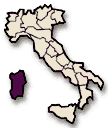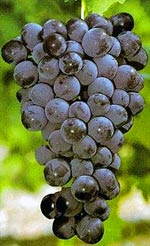 Drink Indigenous is this Wine Blogging Wednesday‘s theme.
Drink Indigenous is this Wine Blogging Wednesday‘s theme.
Well, I’m a dumbass. I thought that the dominant varietal in this wine, Cannonau, was indiginous to Sardinia, one of the Italian islands. Wrong! It’s largely thought that Cannonau was brought to Sardinia in the 18th century from Spain — general consensus seems to be that it’s a derivative of Garnacha, or Grenache. Dissenting Italian opinions here. If a grape has been grown in a region for 4 centuries and has its own name, isn’t it indigenous by now? Probably not. But I tasted this wine up good, damn it, and so you’re going to hear about it.
Deeply purpley-red in color. Immediately in the glass, there’s a dusty-earthy nose, maybe cedar notes, with black licorice and ripe bing cherry. When it opens up, it’s got really ripe, sexy fruit. I can see why Parker gave this a 91 — it’s totally his style! And for only about $14!
On the tongue, it gives up some plum flavors (you know how the skin is a little sour? like that) and has a note of tar, mixed with a slightly minerally tone. It’s rare for me to detect minerality on the palate of a red wine (it’s much easier for me taste that flavor – like rocks in your mouth – in whites), but here it is! Happy Mouth Co-op, membership: me.
I kept thinking “boy, I bet this would be great with food, like a nice strong cheese” and so I made myself a piece of whole wheat toast with a gorgonzola cream cheese spread. Loveliness! The spicy acidity of the gorgonzola was a nice complement to the earthiness of the wine, and the fat in the cheese spread really smoothed the wine out. Those Eye-talians know how to make us some food-appropriate wine, yo.
 So, region: Sardinia (Sardegna, in Italy) is the second largest island in the Mediterranean, and has some catching up to do, compared to the rest of Italy’s wine regions. The wine laws there are on the lax side: you can legally grown Cannoneau anywhere on the island, not just where it would make better wine, for instance. It’s the Argiolas family that makes the island wine-interesting.
So, region: Sardinia (Sardegna, in Italy) is the second largest island in the Mediterranean, and has some catching up to do, compared to the rest of Italy’s wine regions. The wine laws there are on the lax side: you can legally grown Cannoneau anywhere on the island, not just where it would make better wine, for instance. It’s the Argiolas family that makes the island wine-interesting.
 Antonio Argiolas founded his winery in 1938, and when the Italian government was encouraging farmers to pull up their vines in the 70s, twin sons Franco and Giuseppe planted even more vines. The family hired renowned wine consultant Giacomo Tachis, credited with making Antinori the powerhouse it is today, and the whole operation works by its own rules, much more stringent rules than the Italian wine laws of the region. Their wines set the bar high for Sardinia, and very few other wineries come close. (Sella & Mosca is one of those wineries — check them out, too!) The Argiolas family focuses on grapes indigenous to their region, such as, according to Robert Parker, “Nuragus and Vermentino for their whites, and such red grapes as Cannonau, Monica, Carignano, and Bovale Sardo.”
Antonio Argiolas founded his winery in 1938, and when the Italian government was encouraging farmers to pull up their vines in the 70s, twin sons Franco and Giuseppe planted even more vines. The family hired renowned wine consultant Giacomo Tachis, credited with making Antinori the powerhouse it is today, and the whole operation works by its own rules, much more stringent rules than the Italian wine laws of the region. Their wines set the bar high for Sardinia, and very few other wineries come close. (Sella & Mosca is one of those wineries — check them out, too!) The Argiolas family focuses on grapes indigenous to their region, such as, according to Robert Parker, “Nuragus and Vermentino for their whites, and such red grapes as Cannonau, Monica, Carignano, and Bovale Sardo.”
 So really, there’s controversy about my varietal. Sardinians think that the Spanish took their Cannonau home with them during the 18th century and called it Garnacha. The Spanish say they brought their Garnacha with them to Sardinia and the dumb islanders started calling it Cannonau. It reminds me a little of the old Reese’s commercial: “You got your peanut butter on my chocolate! No, you got your chocolate in my peanut butter!” (Sidebar: did you ever notice how in those adds, the girl always carried the peanut butter tub, and the boy always carried the projectile chocolate bar? Creepy.)
So really, there’s controversy about my varietal. Sardinians think that the Spanish took their Cannonau home with them during the 18th century and called it Garnacha. The Spanish say they brought their Garnacha with them to Sardinia and the dumb islanders started calling it Cannonau. It reminds me a little of the old Reese’s commercial: “You got your peanut butter on my chocolate! No, you got your chocolate in my peanut butter!” (Sidebar: did you ever notice how in those adds, the girl always carried the peanut butter tub, and the boy always carried the projectile chocolate bar? Creepy.)
In France, the grape is Grenache, and it’s grown in the Rhone region, blended into Cotes du Rhone, Gigondas, and Chateauneuf de Pape. In Spain, the grape is Garnacha, and it’s grown all over the damn place and also frequently blended. It’s a high-yeilding vine, so it can be difficult to coax complexity from the grapes, but harvesting from ridiculously old vines seems to do the trick.
Cannonau /grenache /garnacha is typically soft, fruit-forward, and not age-worthy. It’s frequently blended into harsher Syrahs and Mourvedres to round out those sharp corners and fatten them up a bit. By itself, it’s a plump and succulent mouthful of hot-to-trot fruity love.
Drink the crap out of this great value wine while it lasts!
4 replies on “Wine Blogging Wednesday #37: Tasting Argiolas Costera 2005”
This wine sounds Delish! Also, GREAT site you have here. Add me to your list of regular readers.
Funny about the confusion! Glad you liked it though!
[…] Wine Scamp tried a Cannonau di Sardegna, thinking it was native. Then she found out it’s actually grenache from Spain. No matter! She loved the Argiolas anyway. [Wine Scamp] […]
In ecology studies, there seems to be a thin line, matter of much debate, between ‘indigenous’ & ‘endemic’– ‘endemic’ would be when a species has arrived by human intervention rather than spores in the wind or waves, but adapts easily & finds a non-invasive niche so that it integrates well into the ‘indigenous’ ecosystem…
My Ma’s family is from Galicia, y por parte de padre, Asturianos– & I tend to believe Sardos may be in the right in this…but who am I anyway?